Welcome to an in-depth exploration of Catfish Farming in the Philippines. In this comprehensive guide, we’ll delve into the fascinating world of raising catfish, focusing on the unique conditions and practices within the Philippines. Discover the essential steps, techniques, and considerations for successful catfish farming, all presented in an easy-to-understand manner. Whether you’re a novice enthusiast or a seasoned farmer, this guide will provide accurate insights and practical knowledge to thrive in catfish cultivation.
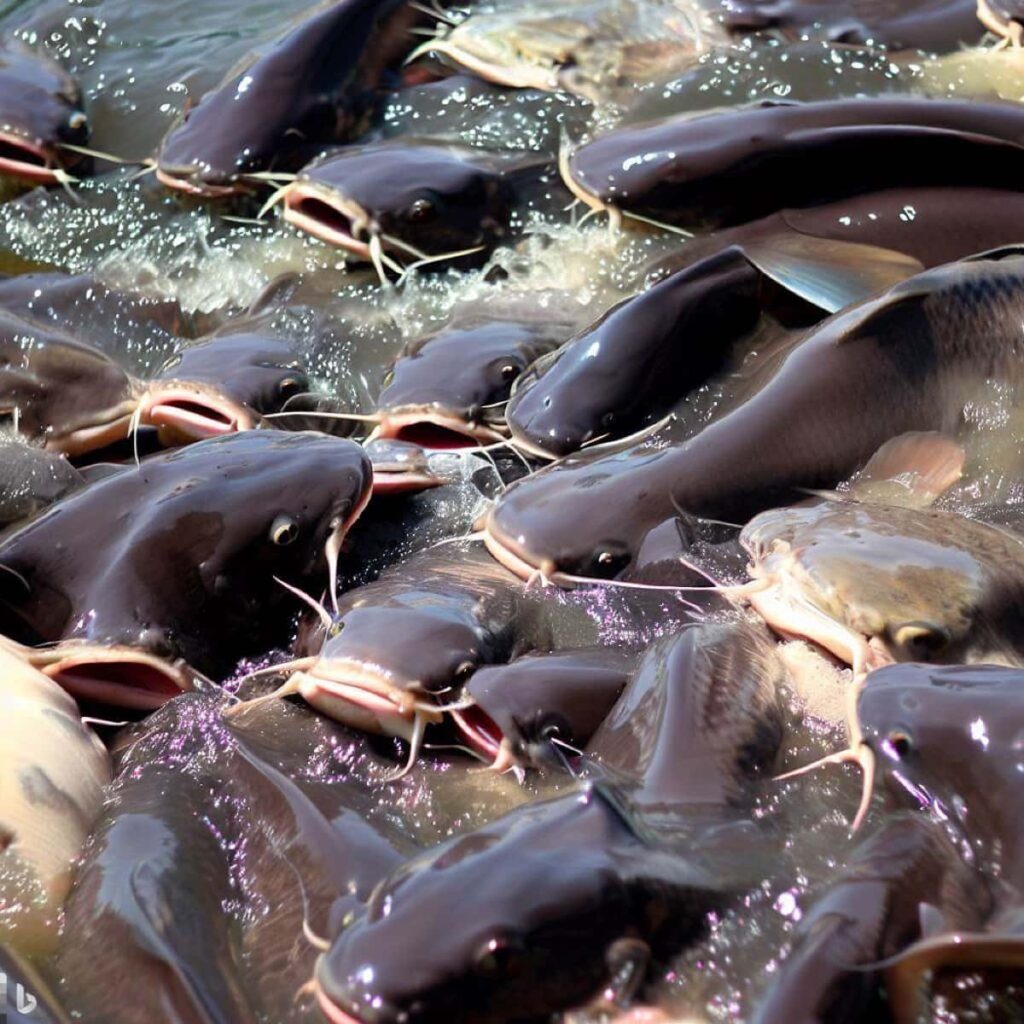
What is Catfish Farming?
Catfish farming involves raising catfish, commonly known as aquaculture, for commercial purposes. Catfish are freshwater fish known for their rapid growth and adaptability to various environments. In this practice, catfish are bred, reared, and harvested in controlled settings such as ponds or tanks.
The process begins with selecting suitable catfish species, providing proper nutrition, and maintaining optimal water conditions. Farmers monitor growth, manage disease risks, and ensure sustainable practices. With a global demand for seafood, catfish farming has gained prominence. It offers economic opportunities, contributes to the food supply, and supports the aquaculture industry’s growth while preserving wild fish populations.
Catfish Farming in the Philippines: Overview
President Ferdinand “Bongbong” Marcos urges citizens to cultivate their sustenance amid rising costs and food scarcity. He has taken over the Department of Agriculture, emphasizing food production, including fisheries. The government recommends rearing tilapia, milkfish (bangus), and two types of catfish (dalag and hito) as essential fish species for personal growth.
The African sharp-tooth catfish, introduced globally in the 1980s, is particularly suitable for small-scale operations, even in compact concrete tanks. A 10-square-meter concrete tank can house up to 1,000 African hito fingerlings, each requiring 75-100 fingerlings per square meter and a protein-rich diet. This initiative empowers households to contribute to food security and fosters self-reliance.
Catfish Farming Techniques in the Philippines
Catfish, particularly Clarias spp. (locally known as hito), holds a crucial role in Southeast Asian freshwater cuisine. It’s favored for its adaptability to various conditions, thriving in limited spaces, and resilience against diseases. Once abundant, Indigenous Philippine catfish (Clarias macrocephalus) has given way to the imported African catfish (C. gariepinus), which has become more prevalent due to its comparable taste and familiarity.
However, the market for African catfish still needs to be developed. Small-scale farms, often integrated with vegetables, dominate the landscape, producing around 500 kg per week. Charlie Guardapes, a notable example, operates an integrated 1,700 m² farm with catfish ponds and diverse vegetable cultivation. He harvests approximately 25 kg of catfish and vegetables every 2-3 months.
In case you missed it: Giant Tiger Prawn Farming in the Philippines: A Comprehensive Guide
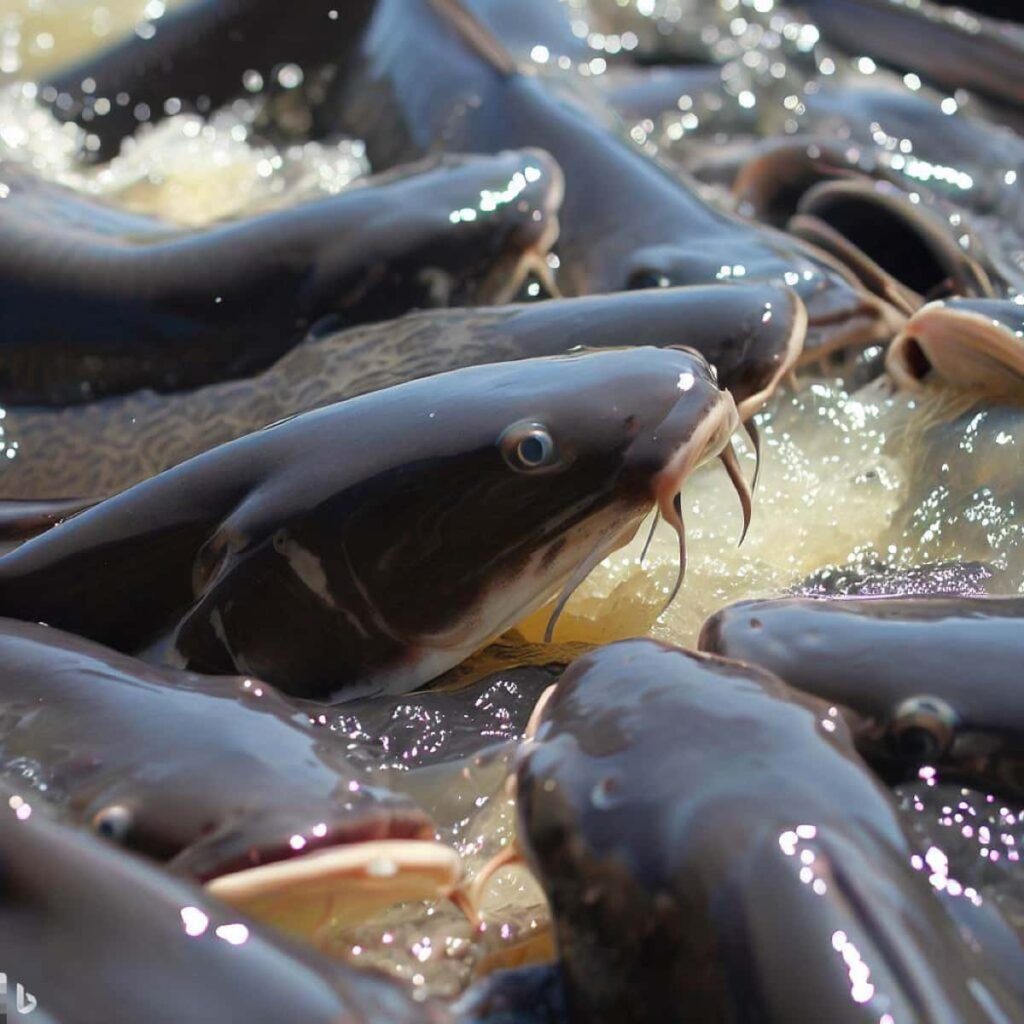
Arsenio “Nonoy” Suoribio manages multiple ponds, harvesting 500 kg weekly using swine pellets for catfish feed. The shift from native catfish to African catfish reflects changing preferences and economic dynamics while showcasing the potential of integrated farming for sustainable livelihoods in the Philippines.
Best Practices for Catfish Farming in the Philippines
When venturing into catfish farming in the Philippines, careful planning and adherence to best practices are vital for success. Begin with a pond suitable to your available space and resources. Starting small, with a minimum 10 square meters surface area and a 1.5-meter depth, is advisable, especially for beginners. A concrete pond can also be constructed, maintaining a natural clay bottom for oxygen and an organic environment, thereby conserving water. For stocking, fingerling size:
- 3cm to 4cm: 80 to 100 fingerlings per square meter; harvest in 5 to 6 months.
- 5cm to 6cm: 60 to 80 fingerlings per square meter; harvest in 4 to 5 months.
Feeding catfish is crucial; offer meat-based sources for optimal growth. Ground chicken intestines, worms, termites, fish meal, and slaughterhouse waste are suitable choices. Provide food twice daily to prevent cannibalism, and maintain a separate pond for larger catfish to avoid predation on smaller ones.
To breed and produce fingerlings, isolate the biggest fish and separate genders. Female catfish begin egg production at 8 to 9 months. While this guide provides fundamental insights, those planning larger operations can seek assistance from the Bureau of Fisheries and Aquatic Resources (BFAR).
Catfish Farming Systems in the Philippines
Larval Rearing
- Transfer 4-6 day-old catfish larvae to tanks with 10-15 cm water depth, stocking at 100-150 larvae/L.
- Provide shelters, mild aeration, and feed thrice daily with newly-hatched Artemia nauplii at ten individuals/mL. Change 30% of water daily.
- For 7-10 day-old larvae, feed water fleas (Moina or Daphnia) at 5-10 individuals/mL, or continue with Artemia nauplii.
- Introduce SEAFDEC/AQD formulated diet on day 10, alongside natural food. Change 50% of water daily.
- Transition to nursery system by day 15.
Grow-out in Ponds
- Drain, level, and dry the pond bottom for 2-3 weeks. Repair structures apply lime (500-1,000 kg/ha) and organic manure (500-1,000 kg/ha).
- Install perimeter fence, allow water to settle for seven days, then apply inorganic fertilizer (16-20-0 at 50 kg/ha) and urea (25 kg/ha). Increase water depth to 50-60 cm.
- Acclimate and stock healthy fingerlings (3-5 g) at 5-20 pcs/m².
- Initiate feeding with 5% of total biomass, gradually reducing by 0.5% monthly up to the fifth month.
- Monitor water quality, fish health, and growth, adjusting management practices as needed.
- Before harvest (3-5 months), detect off-flavor by cooking samples. If detected, investigate and address.
- Harvest at 80-200 grams, holding in tanks with running water before marketing live catfish.
In case you missed it: Green Mussel Farming in the Philippines: A Comprehensive Guide
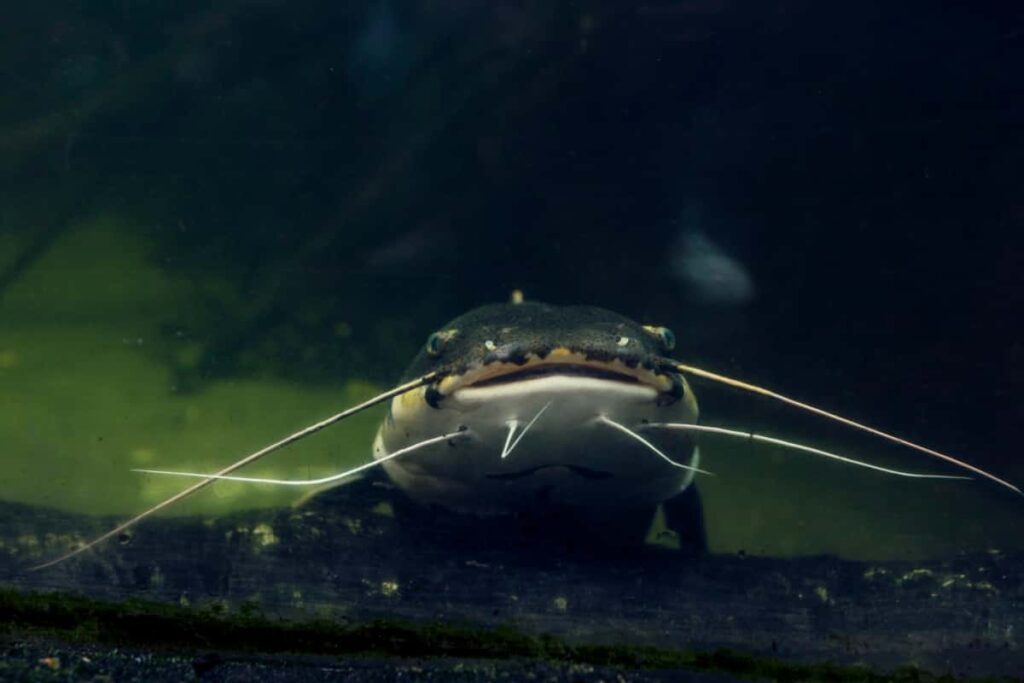
Feeding Strategies for Catfish Farming in the Philippines
- Larvae Nutrition: Catfish larvae are nurtured with newly hatched Artemia nauplii and Moina for the initial stages, transitioning to formulated feed containing 44% protein.
- Fry Growth: Two-week-old fry can be sold or further reared. They thrive with formulated feed, fed twice daily at 20% of body weight, gradually shifting to 5-10% as they grow.
- Nursery Stage: During nursery rearing, tanks or ponds should be fertilized before fry stocking. Formulated feed is provided for optimal growth to reach a suitable size for grow-out ponds.
- Grow-out Phase: Feeding strategies depend on size and age in grow-out ponds. Formulated feed with suitable protein content supports growth, with feeding frequency and rate adjusted accordingly.
Water Management in Catfish Farming in the Philippines
Efficient water management is vital for successful catfish farming. Maintain water quality parameters such as temperature (25-30°C), dissolved oxygen (5-6 mg/L), pH (6.5-8.5), and ammonia levels (<0.5 mg/L) within optimal ranges. Regularly monitor water quality to prevent stress and diseases. Ensure proper aeration and water circulation to maintain oxygen levels and minimize waste accumulation.
Disease Prevention and Control in Catfish Farming
Catfish farming is a complex process that involves managing common diseases like Motile Aeromonad Septicemia (MAS) and Columnaris Disease. These diseases can be controlled through maintaining water quality, minimizing stress, and implementing biosecurity measures. Prevention measures include biosecurity, regular monitoring of water quality, and vaccination for specific diseases. These measures help prevent skin ulcers, gill necrosis, and other health issues in catfish farming.
Catfish Species Suitable for Farming in the Philippines
Bangus requires a large fishpond and dalag, while hito, or African sharptooth catfish, can be raised in concrete tanks. The government promotes two species of hito: native hito and African hito. The African sharptooth catfish, introduced in the 1980s, is a high-yield, larger, faster, and commercially valuable crop.
The Philippines has enough fingerlings for small-scale farming and can be found online through Facebook groups and YouTube videos. A 10-square-meter concrete tank can raise 1,000 African Hito fingerlings, with 75 to 100 fingerlings per square meter and 90% protein feeding. This type of concrete tank catfish farming can be done in backyards.
Catfish Fingerlings Production in the Philippines
- Select Broodstock: Use 6-8 months old catfish broodstock (2:5 male to female ratio) placed in separate containers.
- Hormone Preparation: Depending on the chosen method, prepare hormones like pituitary glands, HCG, LHRHa + PIM, Ovaprim, or Ovatide. Administer dosages according to the female broodstock’s body weight.
- Stripping and Milt Collection: Anaesthetize females and males. Extract testes from males, macerate, and obtain milt solution. Strip eggs from females into a clean bowl and mix with milt solution for fertilization.
- Fertilization and Incubation: Mix eggs and milt solution thoroughly, then transfer fertilized eggs to a net tray inside a hatching trough. Maintain water level and observe hatching progress.
- Larvae Feeding: After hatching, feed larvae with natural food sources like Moina neonates, Artemia nauplii, or Tubifex worms.
In case you missed it: Oyster Farming in the Philippines: A Comprehensive Guide
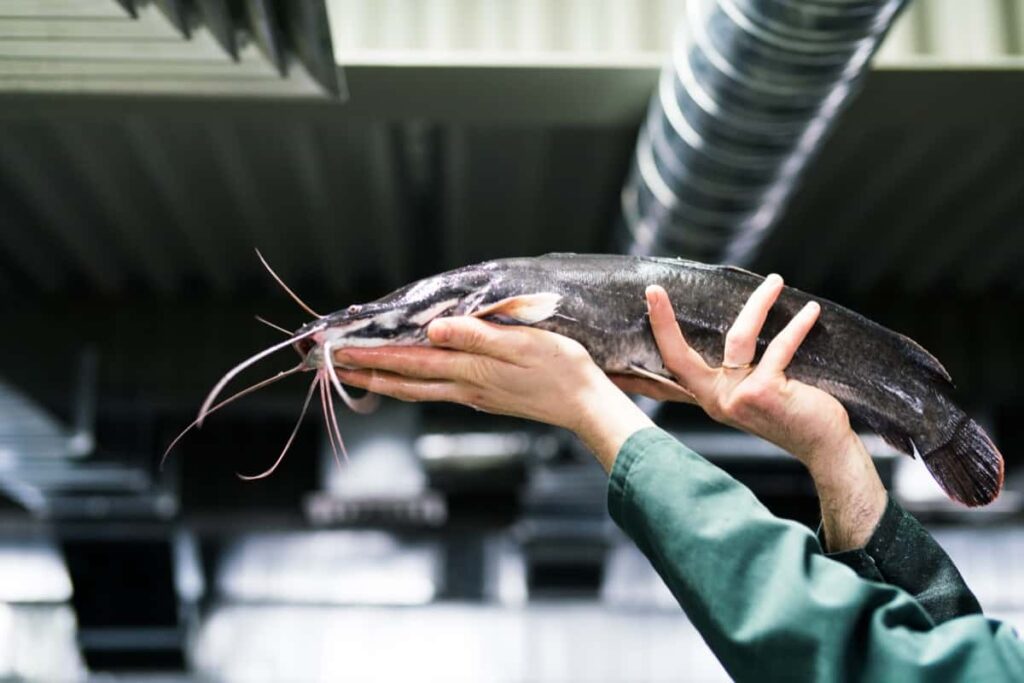
Catfish Feed Formulation and Nutrition Requirements
Catfish, while carnivorous, exhibit dietary flexibility, consuming bottom-dwelling organisms, rice bran, kitchen waste, fishmeal, or specially formulated feeds. A SEAFDEC study unveiled that catfish on a 43% protein SEAFDEC-formulated diet showcased reproductive and larval quality comparable to those fed ‘trash fish. In 6-8 months, larger females prove more prolific, laying 20-90 eggs/g body weight post-hormone injection.
Catfish are year-round carriers of eggs and sperm, but artificial propagation involves hormone-induced spawning and manual egg stripping. Induced spawning success hinges on hormone dosage, the latency period, and the interval between hormone injection and egg extraction. After hatching, catfish larvae are reared with natural food sources like brine shrimp and water fleas. Gradually, they transition to a formulated diet with 44% protein. Feeding frequency and rate vary as fry age.
Tanks or ponds should be fertilized before fry stocking to ensure successful nursery growth. Fry can be stocked at 200-800/m² in tanks or up to 1200/m² in ponds, with net cages enhancing fingerling production. Fingerlings mature in around 28 days, primed for transfer to grow-out ponds. These practices combine effective feeding, controlled breeding, and strategic nursery management to foster thriving catfish aquaculture operations.
Catfish Pond Construction and Design in the Philippines
Catfish pond construction in the Philippines involves tailored design for optimal results. Start small, with a minimum ten m² surface area and 1.5m depth, or consider concrete ponds of similar size. African hito catfish, a profitable choice, can be raised in these setups. A ten m² concrete tank can accommodate up to 1,000 fingerlings with proper stocking and feeding. Utilize 75-100 fingerlings per m², feeding them a 90% protein diet. This approach is convenient for backyard operations, enhancing the country’s potential for successful and sustainable catfish farming.
Economic Analysis of Catfish Farming in the Philippines
Catfish Seed Production Analysis
Technical assumptions span broodstock and hatchery aspects for catfish seed production. Over five years, with 12 runs per year, the operation focuses on four ponds or 12 tanks. Detailed factors include feeding rates, stocking densities, survival rates, and selling prices. The returns on investment are impressive: Internal Rate of Return (IRR) at 158%, return on investment (ROI) at 159%, and a payback period of 0.59 years. This suggests profitable catfish seed production.
Catfish Grow-out in Ponds Analysis
Considering a 5-year project duration on a 1,000 m² pond area, stocking density of 10 pcs/m², and two crops annually, profitability is evident. Technical assumptions encompass feed conversion ratio, body weight, and market price. The operation yields a robust return on investment (ROI) of 80%, with an Internal Rate of Return (IRR) of 148%. The payback period is approximately 1.2 years, reaffirming the viability of catfish grow-out.
In case you missed it: Tilapia Farming in the Philippines: A Comprehensive Guide
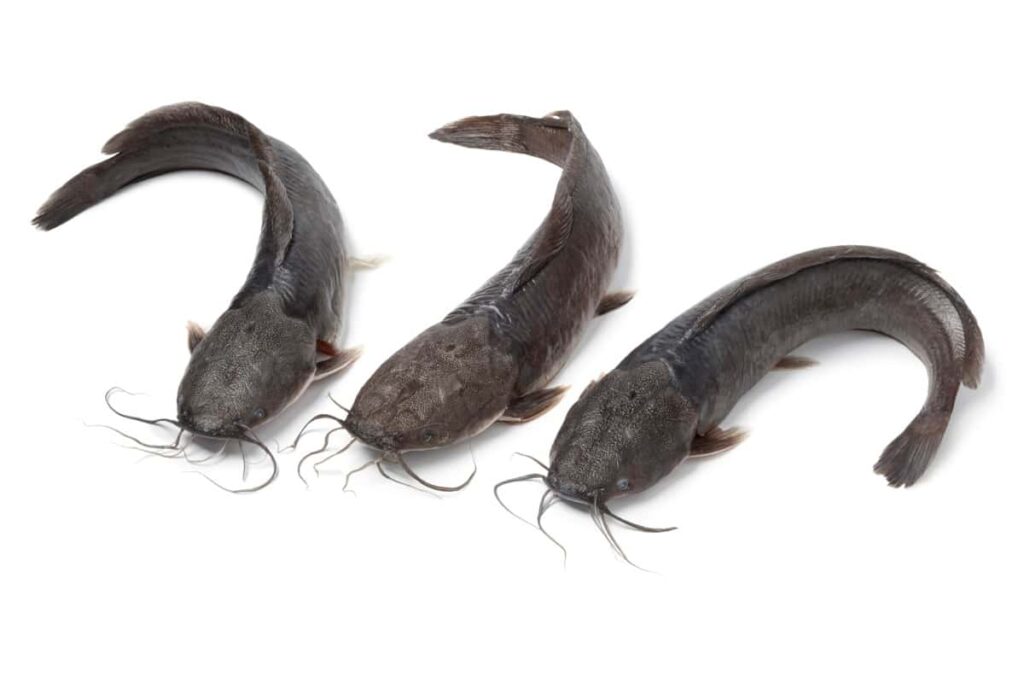
Sustainable Practices for Catfish Farming in the Philippines
The Philippines implements sustainable catfish farming practices, focusing on responsible water usage, minimizing environmental impact, and ensuring economic viability. Small-scale operations are preferred, using concrete tanks for space conservation. African hito catfish, a key species, is used for its high yields.
Breeders use both indigenous and imported fingerlings. Feed management, natural food sources, and disease prevention ensure optimal growth and reduce ecosystem stress. Efficient transport methods maintain fry health during distribution. This approach contributes to food security, economic growth, and environmental preservation.
Catfish Processing and Value-added Products
Catfish processing starts at hatchery and nursery stages, with larvae incubated without feeding for four days before being moved to larger tanks. They are nurtured with Artemia nauplii and Moina for seven days before transitioning to formulated feed rich in 44% protein. Catfish fry are market-ready for sale to grow-out pond operators at two weeks old.
They can be reared in net cages or larger nursery setups for 4-6 weeks. Catfish fry are packaged and transported in plastic bags with water, ensuring survival during transport. Native “bayong” bags are used for short distances, while styrofoam boxes with crushed ice are used for air travel.
Government Regulations and Policies on Catfish Farming
In the Philippines, catfish farming is subject to government regulations and policies that aim to ensure sustainable and responsible practices. The Bureau of Fisheries and Aquatic Resources oversees the aquaculture sector, including catfish farming. Regulatory measures encompass environmental impact assessments, permits, and licenses to prevent negative ecological effects. BFAR promotes species diversity, disease prevention, and sustainable resource management. These policies seek to balance economic growth in the aquaculture industry with environmental conservation.
In case you missed it: Milkfish Farming in the Philippines: A Comprehensive Guide
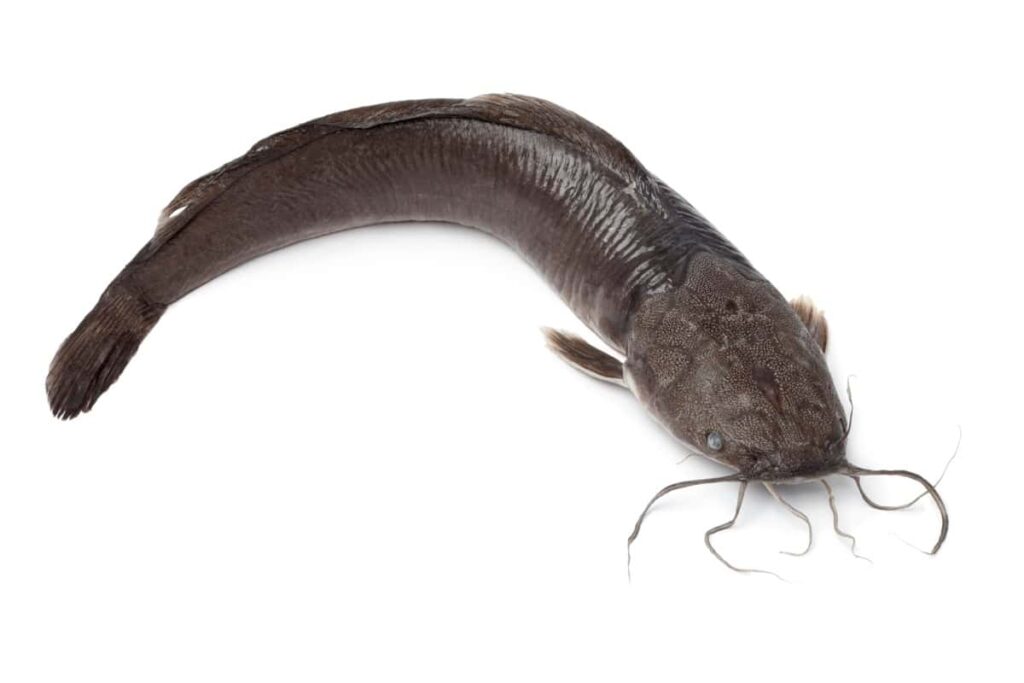
Conclusion
Catfish farming in the Philippines offers a promising avenue for sustainable aquaculture. Adhering to efficient practices, from hatchery to grow-out, while prioritizing environmental stewardship and responsible management paves the way for successful and thriving catfish operations in the country.
- Sheep Farming Business Plan for Beginners
- Aquaponic Farming at Home: A Step-By-Step Guide
- Profitable Village Farming Business Ideas in 2024
- High-Yield Aquaculture: Fast-Growing Fish for Farming
- Effective Fish Pond Construction Techniques for Beginners
- Irrigation and Water Management in Pineapple Farming
- Blossom to Harvest: Mastering Flowering and Pollination in Papaya Farming
- Pig Fattening Essentials: From Selection to Sale for Beginners
- Raising Wagyu Cattle: A Complete Guide for Premium Beef Production
- Soil Types and Their Water Holding Capacity
- Optimizing Irrigation Schedules for Coconut Groves for Enhanced Yield
- Espresso Your Garden: Coffee Grounds for Healthier Acid-Loving Plants
- The Best Soil Mix for Snake Plants: How to Mix Your Own Snake Plant Soil
- Green Thumb Success: Expert Tips for Cultivating Greenhouse Beans All Year Round
- Bloom All Year Round: The Ultimate Guide to Indoor Hyacinth Care
- Eco-Friendly Gardening: How to Make Liquid Fertilizer from Kitchen Waste
- Ultimate Guide to Grow Anise in Pots: Explore Seed Propagation to Harvesting
- Guide to Raising Chester White Pigs: Discover Breed Facts to Growth Management
- Mastering the Elegance: The Ultimate Guide to Weeping Cherry Tree Care, Planting, and Maintenance
- Ultimate Guide to Planting Garlic in Grow Bags: Growing Strategies for Beginners
- How to Fix Spider Plant Leaf-Related Problems: Natural and Organic Remedies
- 10 Reasons Why Your Tulsi Plant is Shedding Leaves: Home Remedies and Solutions
- Optimizing Growth and Yield: The Advantages of Palm Bunch Ash Fertilizer
- Utilizing Neem Oil Extract as a Natural Pesticide for Hydrangea
- From Soil to Harvest: Various Ways in Which Farmers Can Use AI Tools
- Steps to Encourage and Induce Citrus Flowers: A Comprehensive Guide
- How to Fix Snake Plant Leaf-Related Issues: Natural and Organic Remedies
- Transform Your Garden into a Fragrant Oasis with Raat Ki Rani (Night Blooming Jasmine)
- Discover the Ideal Chicken Breeds for Philippine Farms
- How to Create a Poultry Egg Farm Business Plan for Profits
- Grow Lemon Cucumbers Like a Pro: Insider Techniques for Bountiful Yields
- Ultimate Guide to Caring for Your Pink Princess Philodendron: Tips for Thriving Variegation
- Areca Nut Profit Per Acre: Calculating Yield and Cost of Cultivation
- How Kaveri Chicken is Becoming a More Profitable Breed in Indian Backyards
- Transform Your Barn: 9 Steps to Convert a Horse Stall into a Chicken Coop
- Exploring Suffolk Sheep Disadvantages with Limitations and Challenges

I want to know more about catfish tank farming.